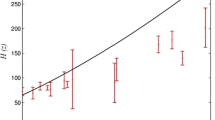Abstract
We consider the astrophysical and cosmological implications of the existence of a minimum density and mass due to the presence of the cosmological constant. If there is a minimum length in nature, then there is an absolute minimum mass corresponding to a hypothetical particle with radius of the order of the Planck length. On the other hand, quantum mechanical considerations suggest a different minimum mass. These particles associated with the dark energy can be interpreted as the “quanta” of the cosmological constant. We study the possibility that these particles can form stable stellar-type configurations through gravitational condensation, and their Jeans and Chandrasekhar masses are estimated. From the requirement of the energetic stability of the minimum density configuration on a macroscopic scale one obtains a mass of the order of 1055 g, of the same order of magnitude as the mass of the universe. This mass can also be interpreted as the Jeans mass of the dark energy fluid. Furthermore we present a representation of the cosmological constant and of the total mass of the universe in terms of ‘classical’ fundamental constants.
Similar content being viewed by others
References
Riess, A.G., et al.: Astron. J. 116, 109 (1998)
Perlmutter, S., et al.: Astrophys. J. 517, 565 (1999)
de Bernardis, P., et al.: Nature 404, 995 (2000)
Hanany, S., et al.: Astrophys. J. 545, L5 (2000)
Peebles, P.J.E., Ratra, B.: Rev. Mod. Phys. 75, 559 (2003)
Padmanabhan, T.: Phys. Rep. 380, 235 (2003)
Mak, M.K., Dobson Jr., P.N., Harko, T.: Mod. Phys. Lett. A 15, 2153 (2000)
Böhmer, C.G.: Gen. Relativ. Gravit. 36, 1039 (2004)
Böhmer, C.G.: Ukr. J. Phys. 50, 1219 (2005)
Balaguera-Antolinez, A., Böhmer, C.G., Nowakowski, M.: Int. J. Mod. Phys. D 14, 1507 (2005)
Buchdahl, H.A.: Phys. Rev. 116, 1027 (1959)
Balaguera-Antolinez, A., Böhmer, C.G., Nowakowski, M.: Class. Quantum Gravity 23, 485 (2006)
Wesson, P.S.: Mod. Phys. Lett. A 19, 1995 (2004)
Aldrovandi, R., Beltran Almeida, J.P., Pereira, J.G.: arXiv:gr-qc/0702065 (2007)
Aldrovandi, R., Beltran Almeida, J.P., Mayor, C.S.O., Pereira, J.G.: arXiv:0709.3947 (2007)
Aldrovandi, R., Beltran Almeida, J.P., Mayor, C.S.O., Pereira, J.G.: arXiv:0710.0610 (2007)
Aldrovandi, R., Beltran Almeida, J.P., Pereira, J.G.: Class. Quantum Gravity 24, 1385 (2007)
Böhmer, C.G., Harko, T.: Phys. Lett. B 630, 73 (2005)
Böhmer, C.G., Harko, T.: Class. Quantum Gravity 23, 6479 (2006)
Böhmer, C.G., Harko, T.: Gen. Relativ. Gravit. 39, 757 (2007)
Weinberg, S.: Rev. Mod. Phys. 61, 1 (1989)
Birrel, N.D., Davies, P.C.W.: Quantum Fields in Curved Space. Cambridge University Press, Cambridge (1982)
Batista, A.B., Fabris, J.C., Houndjo, S.: arXiv:0710.0999 (2007)
Wesson, P.S.: Found. Phys. Lett. 19, 285 (2006)
Trinczek, M., et al.: Phys. Rev. Lett. 90, 012501 (2003)
Peccei, R.D., Sola, J., Wetterich, C.: Phys. Lett. B 195, 183 (1987)
Wetterich, C.: Nucl. Phys. B 302, 668 (1988)
Sola, J.: Phys. Lett. B 228, 317 (1989)
Sola, J.: Int. J. Mod. Phys. A 5, 4225 (1990)
Shapiro, I.L., Sola, J.: Phys. Lett. B 475, 236 (2000)
Dirac, P.A.M.: Proc. R. Soc. A 333, 439 (1974)
Mazur, P.O., Mottola, E.: Proc. Natl. Acad. Sci. 101, 9545 (2004)
Chapline, G.: arXiv:astro-ph/0503200 (2005)
Lobo, F.S.N.: Class. Quantum Gravity 23, 1525 (2006)
Böhmer, C.G., Harko, T.: J. Cosmol. Astropart. Phys. 06, 025 (2007)
Fukuyama, T., Morikawa, M., Tatekawa, T.: arXiv:0705.3091 (2007)
Shapiro, S.L., Teukolsky, S.A.: Black Holes, White Dwarfs, and Neutron Stars. Wiley, New York (1983)
Katz, J., Lynden-Bell, D., Israel, W.: Class. Quantum Gravity 5, 971 (1988)
Author information
Authors and Affiliations
Corresponding author
Rights and permissions
About this article
Cite this article
Böhmer, C.G., Harko, T. Physics of Dark Energy Particles. Found Phys 38, 216–227 (2008). https://doi.org/10.1007/s10701-007-9199-4
Received:
Accepted:
Published:
Issue Date:
DOI: https://doi.org/10.1007/s10701-007-9199-4



